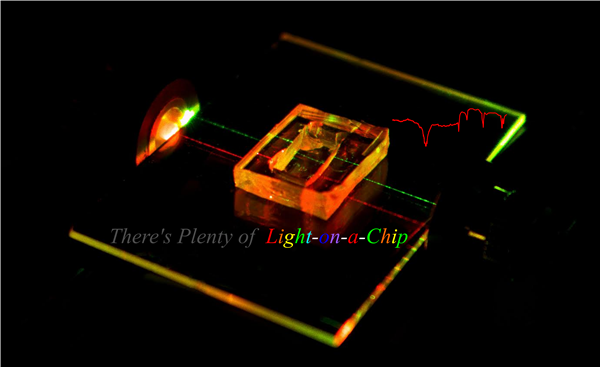Researchers from BGU and the University of Southampton in the UK have made a breakthrough in optical microchips. They inscribed waveguides, channels for the light to flow, on a piece of polished glass, with molecules attracted to the miniature circuit once charged with oxygen. These new optical chips have plenty of bio-medical and optical-communication applications.
One such application is a spectrometer that can provide instantaneous results and is just four millimeters in size. The glass instantly analyzes the material’s chemical properties and reveals its unique signature. The signature is the specific frequency the chemical resonates at when light is passed through it.
Such devices could instantly distinguish between viruses or analyze any material or detect air pollutants.
Current spectrometers are generally several orders of magnitude larger and, in the hospital setting, require a dedicated technician to move from room to room with the device. Moreover, the sample sizes required are substantial – so much so that certain delicate procedures could not be attempted until now lest they harm the patient. Dr. Alina Karabchevsky of BGU, the principal investigator, and collaborator Prof. Alexey Kavokin of the University of Southampton not only miniaturized the entire detection apparatus, they also dramatically reduced the sample size of the material needed to conduct a chemical analysis and identify its signature.
Their pioneering findings were published recently in Scientific Reports. They are the first to use simple glass as the basis for such chips.
“Our new chip could be the basis for a spectrometer at the bedside of every patient in every hospital. The materials we used, glass and light, are plentiful and cheap. Just a drop of a sample placed on one of the waveguides can be analyzed at the speed of light. In fact, a single piece of glass could analyze a number of materials simultaneously,” says Dr. Karabchevsky.
Moreover, Dr. Karabchevsky adds, delicate procedures such as analyzing a sample from a sick baby’s lungs, where all that would be needed was a tiny sample, can now be accomplished. Until now, such procedures required too large a sample size, putting the patient at risk. Other applications include analyzing suspected explosive materials in real time with a handheld device, she says.
“There are many new directions this work encourages us to explore: from fundamental breakthroughs in molecular harmonics excitation under evanescent radiation on a chip to actual devices such as spectrometers on a chip and doctor-in-your-pocket devices. Also, this work paves the way for the broad application of organics-based integrated photonics components, such as filters and switches with increased capabilities, which will revolutionize existing integrated photonic technology which mainly relies on semiconductors today," according to Karabchevsky.
Dr. Karabchevsky is Head of the Light-on-a-Chip group and a member of the Unit of Electro-Optical Engineering Unit and the Ilse Katz Institute for Nanoscale Science and Technology at BGU.
Prof. Kavokin is Chair of Nanophysics and Photonics in the Department of Physics and Astronomy at the University of Southampton.


